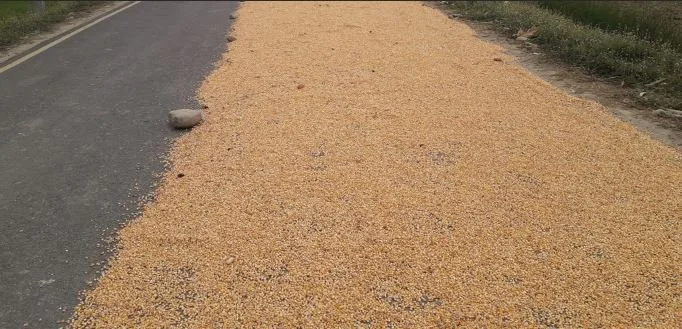From Farm to Market: Fixing Koshi’s Maize Value Chain
Maize cultivation in Koshi Province has been on the rise in recent years, contributing 32 percent of the total maize yield in Nepal[1]. It is driven by attractive market prices and growing cross-border opportunities as India’s demand for maize continues to surge as an energy source. Farmers, both small and large, are producing maize for local consumption and input for the livestock feed industry, where maize accounts for significant portion of total feed composition[2]. The feed industry’s maize demand plays a central role in Koshi’s agricultural economy. With feed demand rising steadily alongside livestock rearing, the demand for maize is predicted to rise continuously. Farmers are motivated by the expanding market of maize, but the value chain remains fragmented and dependent on Indian seeds, fertilizer, and intermediaries.
Photo 1: Maize drying on the blacktopped road (PC: The Rising Nepal)
Nepal currently operates 74 pellet feed mills above 5 tons per hour, of which 17 are in Koshi Province alone. These mills collectively produce about 4,500 tons of feed daily, requiring an estimated 75,600 tons of maize each year. Nationally, the maize requirement stands at nearly 756,000 metric tons annually, with around 52% of the demand in feed mills still met through imports in 2023/24. However, maize imports have been on a steady decline over the past four years, signaling the growing capacity of domestic production. Despite this promising growth, the maize value chain in Koshi remains entangled in a web of challenges.
Constraints in the Field
Land fragmentation: The area under agricultural crops has decreased in Koshi province with the growing migration and the trend of constructing houses and residential structures on agricultural land[3].
Input access: Farmers face delays and shortages in seeds and fertilizers, leading to cultivation setbacks and reliance on uncertified Indian seeds and border-entrance fertilizers of questionable quality and higher prices.
Labor shortages: High migration rates have led to a shortage of agricultural labor, especially in Tarai, increasing production costs and reducing profit margins
Moisture management: Farmers depend on sun drying, which is unreliable during rains; moisture content impacts maize prices, with higher moisture reducing value by Rs. 1 per kg per 1% increase.
Mechanization issues: In Koshi province, practice of using agriculture machinery is not at the desired scale due to lack of custom hiring centers, unsuitability of land due to small land holding and resistance of farmers to shift from traditional practices.
Supply chain hurdles: The porous border causes irregular fertilizer supply, raising concerns over quality and affordability
Inefficient drying technology: Introduced maize dryers are costly (over NPR 6 per kg in diesel), and their feasibility at the farmer level is questionable, requiring further study.
Post-harvest problems: Lack of storage facilities forces farmers into distress sales, making them vulnerable to brokers who dominate market transactions and pocket significant commissions without formal pricing systems.
Harvesting New Possibilities
Amid these struggles, stakeholders see opportunities in establishing drying, storage, and aggregation facilities through cooperatives to reduce post-harvest losses and strengthen bargaining power. To fully realize the potential of maize cultivation, several promising opportunities emerge in Koshi province.
Photo 2: Nepal Wellhope Agri Tech Private Limited (Feed industry) located in Morang
Promoting Contract Farming: Engaging with feed industries and creating transparent pricing platforms could significantly improve market stability and farmer income.
Mechanization as a Solution: Custom hiring centers and highly accurate machines operated by skilled workers offer a promising way to expand maize cultivation efficiently.
Financial Support Systems: Warehouse receipt financing and crop-specific credit products can ease farmers' financial constraints, allowing them to store maize and avoid distress sales.
Banking Benefits: Collateral-free loans tied to stored maize can improve farmers' profitability and enable banks to expand lending while minimizing liquidity issues.
Private Sector and Government Initiatives: Interest from private companies in warehousing and aggregation, along with plans for a centralized cereal mandi in Koshi, aim to streamline marketing and connect farmers directly with traders.
Export Opportunities: The upcoming ethanol factory in Bihar presents a new market for Nepali maize, potentially increasing demand and export prospects.
The RUPANTAR project’s efforts to promote agricultural diversification among smallholder farmers in the Eastern Gangetic Plains are beginning to reshape the maize landscape. By prioritizing mechanization through Zero Tillage technology, and with strong technical backing from CIMMYT-Nepal alongside coordinated support from all levels of government, Koshi’s maize sector holds tremendous promise. Yet, realizing this promise will demand more than innovation alone. Persistent challenges in input supply, storage capacity, and pricing transparency continue to hinder farmers from achieving their full potential. As farmers gear up for the upcoming planting season, the path forward is clear for policy makers and industry stakeholders, now is the moment to act. Investing in robust, farmer-centered value chain reforms could turn Koshi into a model of maize production.
Reference
[1] https://moald.gov.np/content/42/statistical-information-on-nepalese-agriculture/
[2] https://beamexchange.org/media/filer_public/51/21/512158a4-2d16-40e0-b1df-c66b28f5d540/maize_sector_anlaysis_and_strategy.pdf


